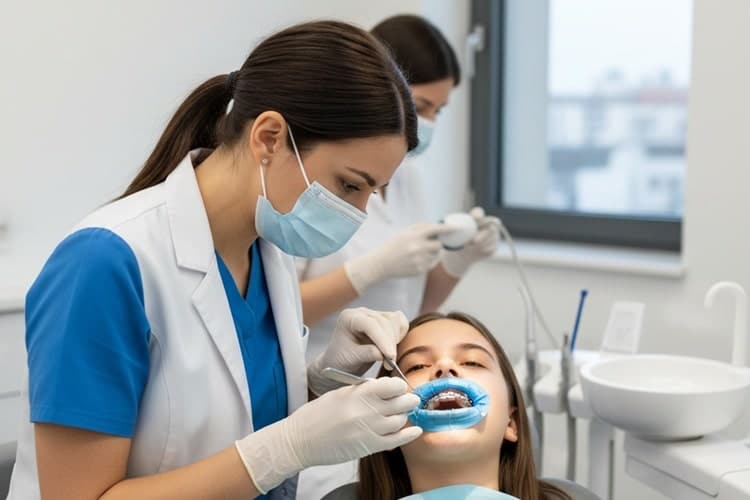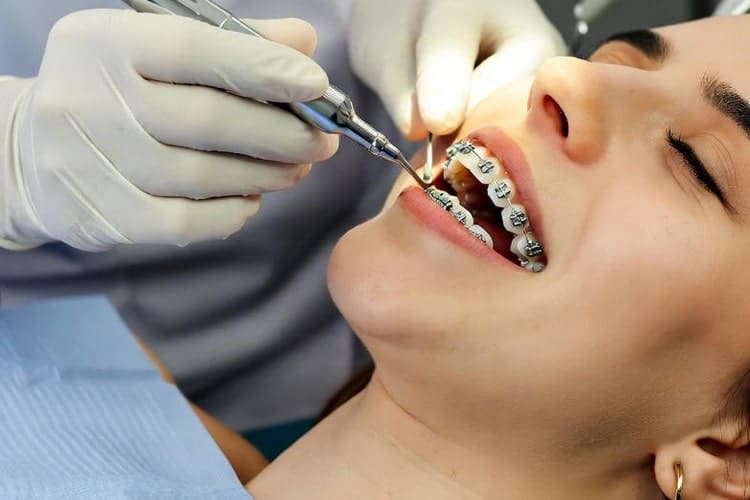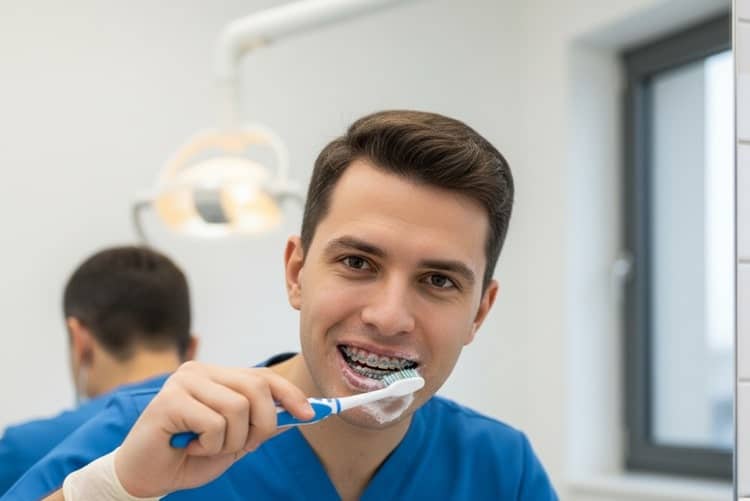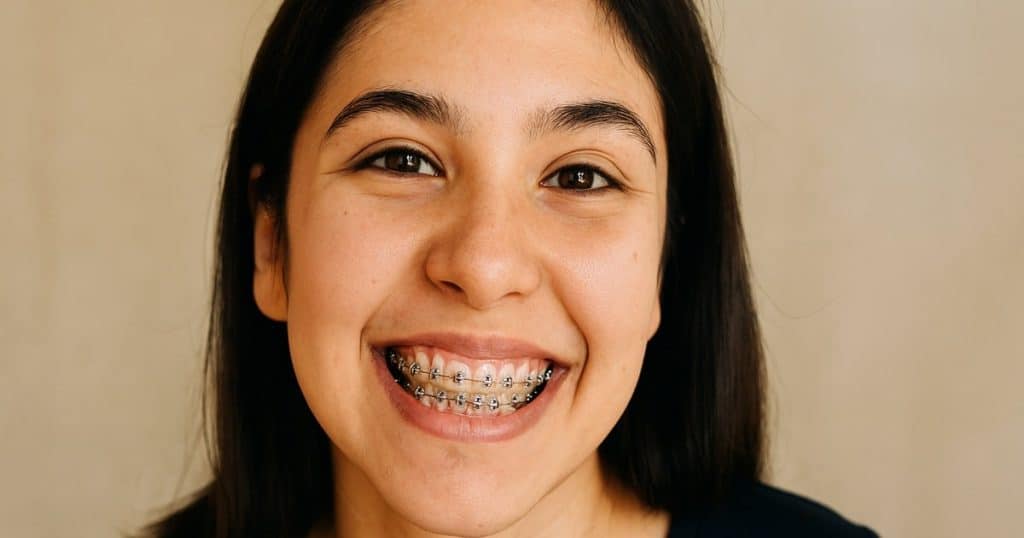We all know that braces can definitely enhance your smile by gradually repositioning and aligning your teeth. An Orthodontist will use special tools and techniques, such as elastics, brackets, and archwires, to solve the issues related to misalignments and bites. Now let’s take a look at the step-by-step braces placement timeline for top and bottom teeth, as well as some post-treatment symptoms and what you should do after the treatment.
Step-By-Step Braces Placement Timeline for Top and Bottom Teeth
It can be helpful to know what to expect before you get the treatment with braces. Here we will learn more about the different stages of the braces placement timeline for top and bottom teeth.
1. Consultation and Evaluation

The first step is to find and meet the orthodontist. You will give them a detailed history, including past dental treatments, oral health issues, habits, etc. Your teeth, gums, bite, and jaw alignments will then be inspected to detect cavities, gum disease, or other problems. They will perform X-rays and digital scans, then analyze the info they have to identify orthodontic problems like crowding, spacing, overbite, etc.
2. Planning and Preparation
You and your orthodontist will define goals such as straightening teeth, improving bite, or addressing facial aesthetics, based on your own concerns and priorities. They will select a treatment method (traditional braces, Invisalign, or specialized appliances) based on your case severity and oral health. You might need to get some dental fillings, tooth extractions, or cleanings done before getting the braces.
3. Braces Placement

Your teeth are cleaned, and a conditioner is applied to the tooth surfaces to prepare them for strong bracket adhesion. They will put bonding glue on your teeth, position the brackets accurately, and use a curing light to harden the adhesive. You might need spacers if your teeth are very close together or metal bands for extra support. An archwire will go through each bracket in the top or bottom row, which puts gentle pressure on the teeth.
Ready to Start Your Journey Toward a Perfect Smile?
At Walk In Family Dentistry, we provide expert orthodontic care and Invisalign treatments to help you achieve a confident, beautifully aligned smile. Whether you need braces or clear aligners, our experienced dentists in Toronto and North York are here to guide you every step of the way.
4. Adjustment and Alignment Phase
You will need regular visits (every 1-4 weeks) to your orthodontist to tighten the archwires, replace ligatures, and check how all the braces are functioning. Braces put consistent pressure on teeth and make them move into their proper alignment. The orthodontist will monitor the progress using visual exams or X-rays to see if everything is going according to plan. A little bit of discomfort is natural after every adjustment and will fade in a few days.
5. Bite Correction
In this stage, your orthodontist will fix the problems in how the upper and lower teeth fit together. They will fix problems like overbite, underbite, crossbite, open bite, and deep bite using specialized appliances like elastics, headgears, or springs. Elastics are attached between upper and lower teeth to help realign the bite. Don’t forget that it happens over months to years, and needs regular orthodontist visits.
Don’t know what overbite is? Check out Overbite Causes & Solutions to learn more about different types of overbites and what the causes are.
6. Space Closure
Space closure is important to eliminate the space created between your teeth due to extractions or misalignment, and to give you a more aesthetic smile. Your orthodontist will replace the archwires and switch to stronger ones using techniques such as power chains, elastics (rubber bands), springs, and loops. This phase usually lasts about 3-6 months and varies based on individual cases and treatment complexity.
7. Finishing and Detailing
This is the final stage of treatment with braces, where your orthodontist focuses on perfecting the alignment, bite, and aesthetics, which lasts about 3-6 months. They will fine-tune individual tooth positions, achieve ideal bite relationships, harmonize the gum line and arch forms, and correct any minor rotations, tipping, or tooth angulations. Orthodontists will bend archwires or reposition brackets to enhance some fine details.
8. Braces Removal (Debonding)

The orthodontist will check the alignment of your teeth and determine if your teeth have moved into their correct positions, then use special tools to gently remove the brackets and break the strong bond of the adhesive. A dental polishing instrument is then used to remove any residual glue or adhesive to make the teeth smooth and clean.
9. Retention Phase
After you remove the braces, it’s essential to prevent relapse so that the teeth will not shift back to their misaligned state. There are two types of retainers that are usually used: removable retainers (clear plastic or Hawley retainers that patients can take out for eating and cleaning) and fixed retainers (bonded wires glued to the back of front teeth that provide permanent support). Retainers might be needed for several years or even a lifetime.
Symptoms You May Have After the Braces Are Placed

So you got your braces treatment (one of the crossbite treatment options) done and went through the braces placement timeline for top and bottom teeth successfully. These are some of the symptoms you should expect after getting braces:
- Your mouth is still not adjusted to braces, and you might experience a dull ache or tenderness in your teeth and gums that can last for several days.
- It may be hard to chew food after getting braces.
- Teeth will be more sensitive to temperature and pressure changes, especially in the first week.
- Your tongue has not adapted to braces yet, so you may feel some speech changes.
- Brackets and wires can irritate your cheeks, tongue, and gums. Orthodontic wax can help reduce the discomfort.
Do you have crooked teeth? Visit Crooked Teeth to find out what the causes are and what you can do about them.
What to Do After Getting Braces for Top and Bottom Teeth?

Now that you know about the stages of braces placement timeline for top and bottom teeth, let’s explore some of the things you should do after you get the treatment with braces.
- Don’t forget about brushing and flossing to prevent plaque buildup and decay.
- You will need appointments every 1-4 weeks for tightening or adjustments.
- You can use over-the-counter pain relievers, ice packs, and salt water rinses to reduce
soreness and inflammation.
- Try not to consume hard, sticky, or chewy foods as they can damage the braces.
Read more: “8 Things You Should Consider Before Getting Braces”
What to Expect When Getting Braces
It’s helpful to learn about the stages of brace placement timeline for top and bottom teeth before you get the treatment done. Expect some discomfort, irritation, and sensitivity in the first couple of days after getting braces, and don’t forget to brush and floss. If you want to transform your smile with Invisalign, Walk In Family Dentistry has the best Invisalign dentists in Toronto and North York. Book an appointment at Invisalign North York.
FAQ
What should I do after getting braces?
After you have received the treatment with braces, brush and floss regularly to prevent plaque buildup and decay, set regular appointments every 4-8 weeks for tightening or adjustments, use over-the-counter pain relievers, ice packs, and salt water rinses to reduce soreness, and don’t consume hard, sticky, or chewy foods.
What are some symptoms I may have after the treatment with braces?
You may experience a dull ache or tenderness in your teeth and gums, difficulty chewing food after the treatment, sensitivity to pressure and temperature changes, speech changes, and irritation to your cheeks, tongue, and gums caused by brackets and wires.
How do braces help solve alignment and bite issues?
They apply consistent and gentle pressure to your teeth and jaws, which gradually moves them to the position they’re meant to be. Orthodontists use elastics (rubber bands) between upper and lower braces to solve issues like overbite, underbite, or crossbite.
How is the braces placement done by an orthodontist?
First, they clean your teeth and apply a conditioner to the tooth surfaces. Then, the orthodontist will use an adhesive to carefully position the brackets on your teeth and use a curing light to harden the adhesive. In both upper and lower rows, an archwire will go through brackets, which applies a gentle pressure to the teeth.
Have you recently started your braces journey or planning to get them soon? Share your experience or ask your questions about the braces placement timeline for top and bottom teeth in the comments below. We’d love to hear from you!



